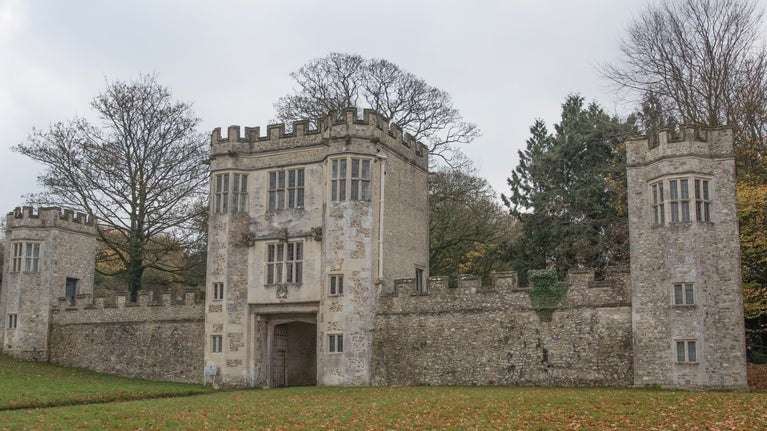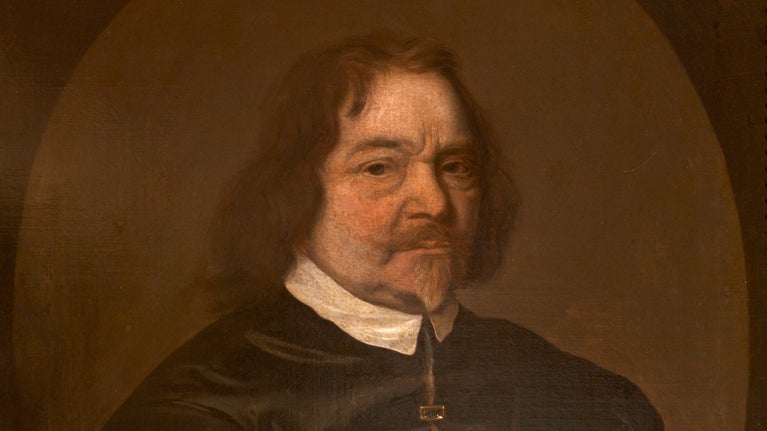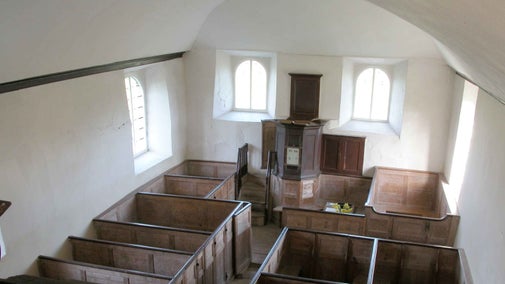
Book your visit
Shute Barton is open for guided tours. Members can book for free, while non-members need to pay when booking.

A manor house at Shute, Devon, was first recorded in the 13th century and built by Sir William Bonville. The house has been rebuilt several times. Abandoned, replaced and left as a farmhouse, it has passed through the Bonville, Grey, Petre, Pole and Carew families until it was transferred to the National Trust in 1959.
There are two houses by the name of Shute. The earlier Shute House is now called Shute Barton and is owned by the National Trust. The second, New Shute House, was built in the later part of the 18th century in the grounds, and is now a private residence.

The Bonville family probably already owned some land at Shute before increasing that significantly when Sir Nicholas Bonville (d. 1299) married Hawyse (or Hawise), co-heiress of Sir Thomas de Pyn (c. 1244–1290) of Devonshire. A traditional medieval style manor house with hall and chambers is recorded in the will of Sir William Bonville (d. 1407) but it is thought to be his successor, William, Lord Bonville (1392–1461) who rebuilt the house in a grand scale to reflect his national standing. During the dynastic conflict for the English throne known as the Wars of the Roses (1455–87), William fought for the Plantagenet House of York. He was captured and executed after the Battle of St Albans. Both his son and grandson predeceased him, and his property was forfeited to the Crown.
Shute House was later restored to the family through Williams grand-daughter, Cicely Bonville (1460–1530). One of the most influential, well connected and wealthy women of Tudor England, she was born at Shute during the Wars of the Roses, in which her male relatives were killed or executed, meaning that before she was just a year old, she had become the wealthiest heiress of her time. Cicely later made use of that wealth to extend the original Shute manor to create what was one of the greatest buildings in Devon. Today only a fragment, the kitchen wing and outer courtyards, remain of the original complex of grand buildings, courts and gardens that would have stretched across a much more extensive area. The great fireplace of the early kitchens, over 7m wide and 3m deep, gives an idea of the scale of that original house.
Royal connections and allegiances increased during the Tudor period. Cicely’s great-granddaughter and inheritor of Shute estate was Lady Jane Grey (1537–54), granddaughter of King Henry VII. Jane was named as his heir by King Edward VI, the only surviving son of King Henry VIII. Proclaimed Queen on 10 July 1553, just nine days later she was deposed by Queen Mary I and in 1554, aged 16 or 17, was executed. Shute was again taken from the Bonville’s and returned to the ownership of the English Crown.

In 1560 Shute was purchased by William Pole (1514–87) with his wife Katherine Popham (d.1588). Both William and their son, also William, were significant local and national figures and both served as members of Parliament. The younger Wiliam Pole (c. 1561–1635) was known as ‘William the Antiquary’ as he made extensive studies of the history of Devon, recorded the lineage and pedigrees of gentry families and collected related documents. His work referenced at least 4600 historical documents in the West of England and was the basis for research by many later historians. William lived at Shute for 30 years, his most significant work ‘Collections towards a Description of Devonshire’, was published in 1791 by his ancestor Sir John William de la Pole 6th Bt.
The Pole family and their wider relations were active investors in the global networks that were developing at this time, particularly the enterprises to establish colonies in North America. Their interests were both economic and religious.
They invested in the Virginia and Dorchester Companies, which supported new settlements in North America, and they expected a financial return from these endeavours.
At least two family members who lived at Shute, sister and brother Elizabeth (1588–1654) and William Pole (1593–1675), children of William ‘the Antiquary’, emigrated to America seeking religious freedom and with a mission to spread Christianity to existing populations.
Elizabeth was a follower of Reverend William Hook, a local Puritan vicar at Axemouth. In 1637 she sailed on the ‘Speedwell’ from Weymouth to North America with Reverend Hook and other Puritans for the new settlement of Dorchester, Massachusetts. William Pole had previously sailed to the Plymouth Colony, the first English settlement in New England.
Brother and sister later moved further south, and in about 1637 Elizabeth may have been part of the purchase of an area called Cohannet, Tetiquet or Titiquet, part of the land of the Wampanoag. She and William founded Taunton, Raynham and Berkeley in Massachusetts.
Elizabeth is reported to have been instrumental in organising the exploitation of local raw materials. William was prominent in the development of the Plymouth colony which later merged with the Massachusetts Bay Colony. They both remain well-known figures in the history and founding settler narratives of Massachusetts.
Their descendent Sir John Pole 5th Baronet (1733–60) was born and died at Shute. He married Elizabeth Mills (d. 1758) daughter and co heir of John Mills a banker and sugar planter of St. Kitts, in the Caribbean, and Woodford, Essex. Elizabeth inherited extensive plantations and enslaved people in St Kitts from her father, as did her son Sir John William de la Pole 6th Baronet (1757–99).
Within the estate, John and his wife Anne Templer (1758–1832) built a new Shute House. They also extended the estate, acquiring additional properties including neighbouring farms. Renowned for their lavish hospitality their guests included the future King George IV who visited the new Shute House, probably late in 1789. The old building became known as Shute Barton and following demolition of the greater part in about 1786, it was let to a series of tenant farmers.
The last descendent of William de la Pole (1757–99), who had built new Shute House was Sir Frederick de la Pole 11th Baronet (1850–1926), High Sherrif of Devon. Without children of his own, he left the estate to a distant connection, Sir John Gawen Carew Pole (1902–1993) of Antony House in Cornwall, a landowner, a Colonel in the Coldstream Guards and Lord Lieutenant of Cornwall. He was a descendent of Carolus Pole (1686–1731), younger brother of the 4th Baronet. Following his inheritance the Carew family adopted ‘Pole’ becoming the ‘Carew Pole’ family.
Family portraits and papers from Shute were moved to Antony House. The collection at Antony today includes the collected manuscripts of William the Antiquary and portraits of Sir John William and Anne Templar.
By the mid-20th century, Shute Barton had been regularly adapted to meet the needs of tenants over the years. Between 1952–5 a programme of structural repairs and conservation was undertaken funded by Sir John Carew 13th Baronet OBE (1938–2024) and with other public bequests and grants.
In 1959 Sir John gave the property to the National Trust. For some years it remained tenanted but now operates as holiday accommodation with regular, limited opening to the public. A handful of items related to Shute Barton remain at the property with family portraits and papers in private ownership at Antony House.

Shute Barton is open for guided tours. Members can book for free, while non-members need to pay when booking.
Shute Barton is open for pre-booked tours on selected dates through the year. Find out how to book and what you can see during your visit including an informative tour with time to wander around the garden at your leisure at the end.

The history of Loughwood Meeting House is one of secrecy and religious persecution dating back 300 years. Discover more of its story up until it was handed to the Trust in 1969.
